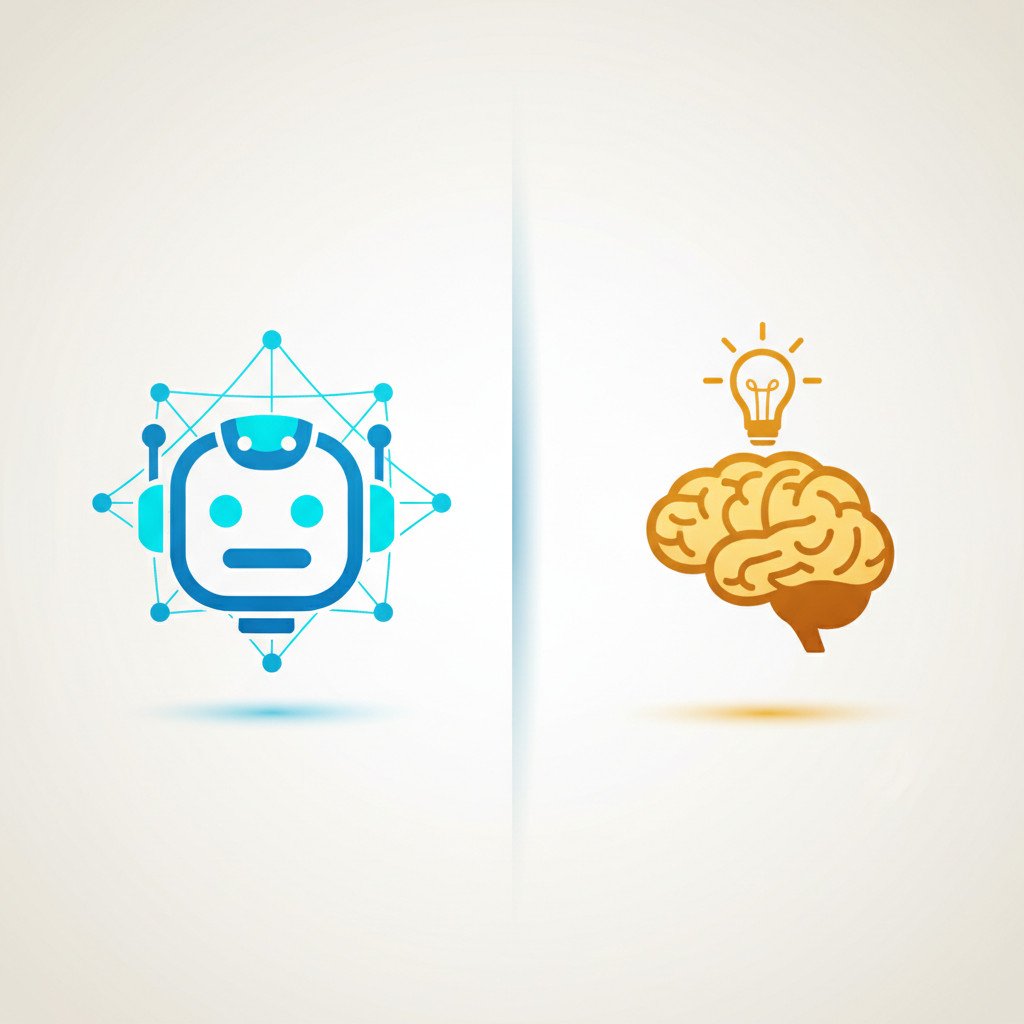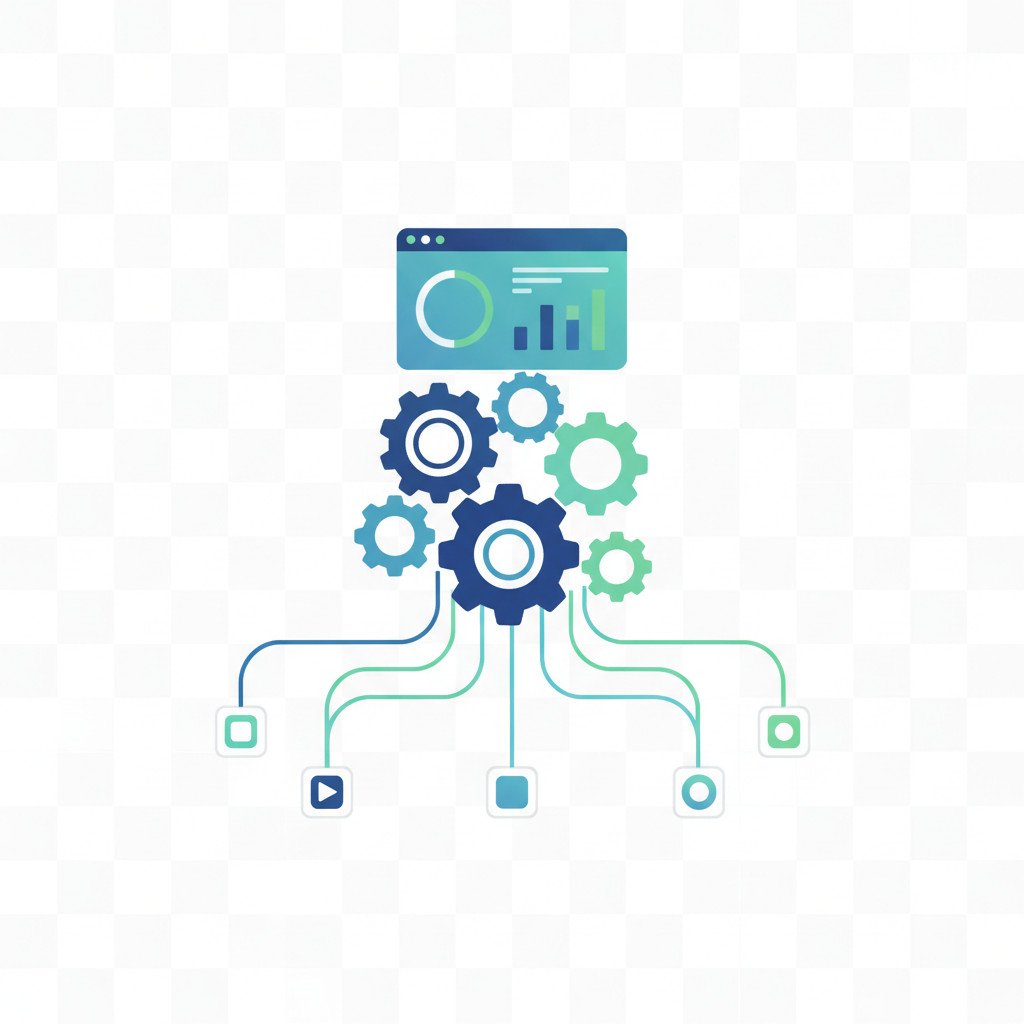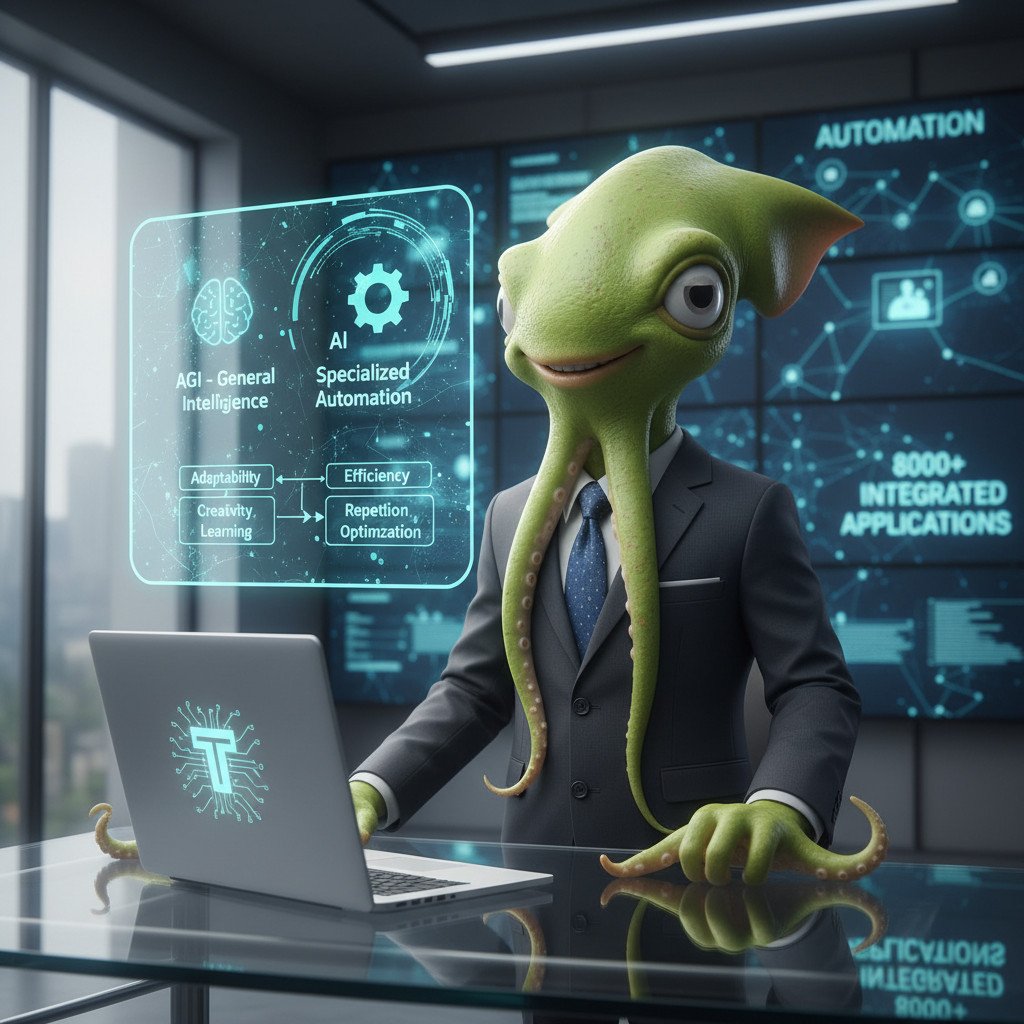AGI vs AI difference: What Every Product and Business Leader Must Know
Confused by headlines that promise machines with human-like minds? Understanding the AGI vs AI difference matters for strategy, risk, and product roadmaps. Because the terms sound similar, teams often make costly assumptions that slow product delivery and create governance gaps. However, clarity here buys focus and safer innovation.
Today’s AI already improves search, drafts emails, and recommends content. However, most current AI solves one task at a time and cannot transfer learning across domains. AGI would instead learn, reason, and adapt across many domains like a human. Therefore, the gap between narrow AI and true AGI shapes how leaders invest and govern technology.
This article breaks down the AGI vs AI difference in clear, practical terms. We explain technical definitions and give real-world examples you can act on today. Then we cover governance, trust, and lessons from recent rollouts that changed enterprise behavior. Also, we outline practical automation patterns using tools such as Zapier to speed workflows while reducing risk. Finally, we offer a checklist leaders can use now to align teams, prioritize use cases, and prepare for future shifts in capability.
What AI Is and Its Types: Understanding the AGI vs AI difference
Artificial Intelligence, or AI, describes systems that perform tasks that previously required human intelligence. Because the term covers many technologies, leaders often confuse goals and risks. Therefore, getting clear about the AGI vs AI difference helps teams prioritize products and governance early.
At a high level, AI breaks down into a few practical categories:
- Narrow AI (also called weak AI)
- Focuses on one task, such as search ranking, spam filtering, or recommendation systems.
- It learns patterns from data and applies them repeatedly.
- For example, ChatGPT generates text for chat and drafting emails.
- General AI (Artificial General Intelligence or AGI)
- Would work across many domains and transfer learning between tasks.
- AGI remains theoretical and does not exist today.
- Superintelligence
- Refers to intelligence that far exceeds human abilities.
- This concept is speculative and drives long term strategy conversations.
Why these distinctions matter
- Product teams need clear scope and success metrics because narrow AI succeeds at measurable tasks.
- However, AGI would change hiring, compliance, and roadmap assumptions.
- Also, enterprises can adopt automation patterns now to gain value while preparing for future shifts. For guidance on enterprise-level implications see How Will AGI vs AI Reshape Enterprise Automation—And What Should You Do Today? and What Do Executives Need to Know About AGI vs AI Right Now?.
For deeper technical background, review the GPT rollout lessons that altered governance and trust. Also, consult general AI primers like Wikipedia’s Artificial intelligence page to compare definitions.

What AGI Is and How It Differs From AI: AGI vs AI difference
The AGI vs AI difference matters because it changes what machines can do and how businesses should prepare. In short, artificial general intelligence aims to match humanlike versatility. However, most systems today are narrow and task specific.
What AGI means
- AGI stands for Artificial General Intelligence.
- It would perform many tasks across domains without retraining.
- In theory, AGI can learn new skills and apply reasoning like a human.
How AGI fundamentally differs from today’s AI
- Scope and flexibility
- Narrow AI handles one problem well.
- AGI would switch contexts and solve varied problems without task-specific tuning.
- Transfer learning
- Narrow models need new data for new tasks.
- AGI would transfer knowledge between domains naturally.
- Autonomy and planning
- Most AI follows rules or predictions.
- AGI could set goals, plan, and adapt strategies across changing environments.
- Robust reasoning
- Narrow AI often uses pattern matching.
- AGI aims for causal reasoning and long-term planning.
Analogies that clarify the gap
- Power tool versus Swiss army knife
- Narrow AI is like a drill. It excels at drilling.
- AGI is like a Swiss army knife. It switches tools when needed.
- GPS versus hired driver
- A GPS gives turn-by-turn directions within known rules.
- An AGI driver would reroute, negotiate with other drivers, and improvise repairs.
Why this matters for product and business leaders
- Timeline and risk
- No true AGI exists yet, so plan for current capabilities.
- However, think long term about governance and staff roles.
- Investment and roadmaps
- Prioritize narrow AI for immediate ROI.
- Yet design architectures that can incorporate more general models later.
- Governance and trust
- Recent rollouts changed enterprise practices, so review lessons from Speed vs Trust: The GPT-5 Rollout That Spooked Enterprises and Redrew AI Governance.
For technical background and definitions, see Wikipedia’s Artificial intelligence page for a broader primer.
| Characteristic | Narrow AI | AGI |
|---|---|---|
| Definition | Systems that solve one specific task using data and patterns. | Hypothetical, general-purpose intelligence that can reason across domains. |
| Scope and flexibility | Task specific; high performance on narrow tasks. | Domain-general; adaptable across tasks and contexts. |
| Learning and transfer | Requires retraining or new data for new tasks. | Would transfer knowledge between tasks naturally. |
| Autonomy and planning | Limited autonomy; follows predictions or rules. | High autonomy; sets goals and plans across problems. |
| Examples | Spam filters, recommendation engines, ChatGPT for text generation. | No confirmed real-world examples yet; thought experiments like a project manager AGI. |
| Applications today | Search, email drafting, personalization, automation workflows. | Long-term research, scenario planning, strategic risk assessment. |
| Limitations | Fragile to distribution shifts; needs labeled data. | Unknown risks; hard to verify and govern. |
| Current status | Widely deployed across industries. | Theoretical; not yet achieved. |
| Business implications | High immediate ROI; easy to measure impact. | Requires governance, new roles, and long planning horizons. |
Real-World Applications of AI and AGI
AI already powers real products across industries. However, AGI remains speculative and affects long-term planning. Below we list current uses and emerging scenarios with short case studies.
-
Healthcare
Narrow AI helps radiologists find cancers faster by flagging suspicious scans. For example, a hospital used an AI triage model to cut review times and catch early-stage tumors, which improved patient outcomes. Because safety matters, regulators like the FDA provide guidance for AI/ML medical software FDA Guidance on AI/ML Medical Software.
-
Finance
Banks use AI for fraud detection, underwriting, and portfolio optimization. AI detects subtle fraud patterns in transaction streams and reduces false positives. As a result, teams can focus on complex cases.
-
Marketing and sales automation
AI personalizes messages and predicts churn. For instance, a small marketing team used AI to score leads and then automated follow-ups across apps with Zapier to increase conversion rates. Also, Zapier connects thousands of apps to orchestrate these workflows Zapier Apps.
-
Autonomous vehicles
Companies test AI stacks for perception and control. For example, Waymo runs fleets that combine sensors and models to drive in city traffic Waymo. However, full autonomy still faces rare-edge-case challenges.
-
Manufacturing and supply chains
AI forecasts demand, schedules maintenance, and optimizes routes. Predictive maintenance prevented a costly line shutdown in one factory, saving time and money.
-
Customer support and knowledge work
AI triages tickets, drafts responses, and summarizes documents. This frees employees to handle judgment-heavy tasks. Imagine an AGI that could onboard new hires by teaching processes and answering questions across systems.
Short AGI vignette
-
Picture a project manager AGI that learns your product, reallocates resources, and negotiates deadlines autonomously. Although fictional today, this story clarifies the stakes for governance and roles.
Each use case shows clear ROI now. However, leaders should plan architectures and governance to adapt if more general capabilities arrive.

Benefits and Challenges of AGI and AI
Both AI and the idea of AGI promise major gains. However, they also create hard trade offs for leaders. This section lists the main benefits and the key challenges. It aims to help product and business teams choose actions that balance opportunity and risk.
Benefits
- Faster decision making and efficiency
- AI automates routine analysis, so teams move faster.
- As a result, organizations reduce manual work and lower costs.
- Improved accuracy and personalization
- Models find patterns humans miss.
- Consequently, customers get more relevant experiences.
- New products and revenue streams
- AI enables features that were impossible before.
- For example, predictive maintenance saves factories time and money.
- Scalability of knowledge work
- AI helps scale tasks like summarization and routing.
- Therefore, small teams deliver larger outcomes.
- Long-term potential of AGI
- AGI could handle cross-domain problems without retraining.
- In theory, this reduces friction across complex workflows.
Challenges and risks
- Bias and fairness
- Models learn human biases in their training data.
- Thus, they can reinforce unfair outcomes if unchecked.
- Safety and reliability
- Narrow AI can fail unpredictably on rare inputs.
- AGI would increase the stakes because failures could cascade.
- Economic disruption
- Automation can shift job roles and skill needs.
- Therefore, firms must reskill workers to avoid harm.
- Governance and accountability
- Assigning responsibility remains hard when systems act autonomously.
- Leaders must create clear ownership and auditing practices.
- Technical hurdles
- AGI requires breakthroughs in transfer learning and causal reasoning.
- Also, scaling compute and data safely remains expensive.
Practical next steps for leaders
- Start with measurable narrow AI pilots that show value quickly.
- Meanwhile, build policies and audits for model fairness and safety.
- Finally, consult risk frameworks such as NIST’s AI Risk Management Framework for guidance on governance and evaluation.
Future Trends and Predictions for AGI and AI
AI progress will accelerate in targeted directions, but true AGI remains uncertain. However, leaders must prepare for steady improvements in capability and governance.
Key research directions
- Multimodal learning and memory systems
- Models will better combine text, images, audio, and code.
- As a result, systems will perform richer, context aware tasks.
- Transfer learning and continual learning
- Researchers focus on models that learn once and adapt.
- Therefore, fewer labeled datasets will be needed for new tasks.
- Causal reasoning and neuro symbolic methods
- Teams pursue causal models to improve robustness.
- Consequently, systems should explain decisions more reliably.
- Efficiency and hardware co design
- Innovation will reduce compute costs through model sparsity and chips.
- This shift makes advanced models affordable for more firms.
Predicted breakthroughs and timelines
- Short term (1 to 3 years)
- Expect stronger multimodal assistants and domain specific generalists.
- Also, enterprises will standardize model governance and monitoring.
- Medium term (3 to 7 years)
- We may see more emergent capabilities and reliable transfer learning.
- However, timelines remain uncertain and debated among experts.
- Long term (7 plus years)
- AGI could emerge if multiple breakthroughs align.
- Yet many researchers caution that AGI is speculative today.
Expert perspectives
- Steve Wozniak once noted a true AGI could complete open ended household tasks.
- Others argue, “We’re not at AGI yet, and that’s probably fine,” because narrow AI delivers real value now.
What leaders should do now
- Invest in narrow AI that solves measurable problems.
- Build governance and reskilling plans alongside innovation.
- Finally, monitor research trends and prepare flexible architectures.
Conclusion: Clear next steps on the AGI vs AI difference
Understanding the AGI vs AI difference arms leaders with realistic expectations. Narrow AI delivers measurable wins today. However, AGI represents a theoretical leap in versatility and autonomy. Therefore, focus on immediate value while preparing governance and architecture for potential future shifts.
EMP0 is a US based AI and automation solutions provider that helps teams turn AI into growth. EMP0 specializes in sales and marketing automation, and offers tools to automate lead enrichment, personalize outreach, and orchestrate AI powered workflows across apps. As a result, teams scale revenue operations without bloated headcount.
For practical guidance and deeper reading, explore how AGI and AI reshape enterprise automation, what executives need to know, and lessons from recent rollouts: AGI vs AI in Enterprise Automation, AGI vs AI for Executives, Speed vs Trust in AI Governance.
Take action now: pilot narrow AI projects, invest in governance, and partner with providers like EMP0 to operationalize automation safely. Finally, visit EMP0’s blog for templates and case studies that show how to apply these ideas in weeks, not years.

